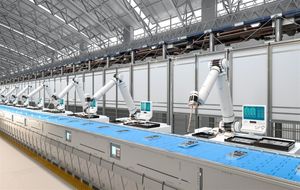
AutoZone (NYSE: AZO), the automotive aftermarket retail giant, unveiled its fiscal fourth-quarter 2025 results on September 23, 2025, presenting a nuanced picture of consumer spending in a dynamic economic landscape. While the company largely met revenue expectations with robust sales growth, a notable miss on earnings per share (EPS) sent ripples through the market, causing an immediate dip in the company's stock price. This divergence highlights the ongoing pressures on profitability within the retail sector, even as demand for essential automotive parts and services remains resilient.
The earnings report serves as a critical barometer for the health of the automotive aftermarket, an industry often seen as recession-resistant due to the necessity of vehicle maintenance. AutoZone's performance, particularly its ability to drive sales across both its Do-It-Yourself (DIY) and Do-It-For-Me (DIFM) segments, offers valuable insights into how consumers are prioritizing vehicle upkeep amidst evolving economic conditions. The market's reaction underscores the importance of bottom-line performance in investor sentiment, even when top-line figures appear strong.
AutoZone's Q4 Performance: A Closer Look at What Happened and Why It Matters
On Tuesday, September 23, 2025, AutoZone (NYSE: AZO) reported diluted earnings per share of $48.71 for its fiscal fourth quarter, which concluded on August 30, 2025. This figure fell short of the consensus analyst expectation of $50.86, representing a miss of approximately $2.01 per share. Despite the EPS shortfall, the company's net sales reached $6.24 billion, aligning closely with analyst forecasts that hovered around the $6.24 billion to $6.25 billion mark. When adjusted for an extra week in the prior year's quarter, sales growth was even more impressive at 6.9%.
The immediate aftermath saw AutoZone's stock price experience a negative reaction, declining by over 4% initially and settling down by 3.2% in early trading. This market response signals that while investors appreciate top-line growth, profitability remains a paramount concern. The primary culprit for the EPS miss and margin pressure was an $80 million non-cash LIFO (Last-In, First-Out) charge, which significantly impacted the gross profit margin, leading to a 98-basis point decline to 51.5%. Additionally, operating expenses increased to 32.4% of sales, driven by strategic investments in growth initiatives.
These results matter because they provide a clear window into the current state of the automotive aftermarket. The solid 5.1% increase in total company same-store sales, with domestic same-store sales up 4.8%, indicates robust consumer demand for automotive parts and accessories. Both the DIY and commercial (DIFM) segments demonstrated steady improvement throughout the quarter, with pre-earnings analyst projections suggesting DIFM growth at 11% and DIY growth at 1.5%. This dual-channel strength underscores the ongoing necessity of vehicle maintenance and repair, whether consumers choose to perform the work themselves or rely on professionals.
The increased inventory by 14.1% year-over-year also signals AutoZone's commitment to supporting its growth initiatives and ensuring product availability. However, the LIFO charge and increased operating expenses highlight the challenges retailers face in maintaining profitability amidst inflationary pressures and significant investments. The ability of companies like AutoZone to manage these costs while continuing to grow market share will be a key determinant of future success.
Market Implications: Winners, Losers, and Shifting Dynamics
AutoZone's (NYSE: AZO) Q4 results are likely to send varied signals across the broader market, particularly within the retail and automotive sectors. The immediate impact on AZO's stock, with its initial decline, suggests that investors are highly sensitive to profitability metrics, even when sales figures are strong. This could lead to increased scrutiny on other retail companies reporting earnings, prompting a closer look at their gross margins and operating expenses. Companies that can demonstrate efficient cost management alongside revenue growth may see their valuations strengthen, while those facing similar margin pressures could experience investor skepticism.
Within the automotive aftermarket, AutoZone's performance offers a mixed bag. The robust same-store sales growth, particularly in the DIFM segment, bodes well for other players in the commercial auto parts supply chain, such as distributors and smaller independent repair shops. These entities could benefit from the sustained demand for professional automotive services. However, the gross margin contraction faced by AutoZone due to LIFO charges might signal broader inflationary pressures on inventory costs that could affect the entire industry. Competitors like O'Reilly Automotive (NASDAQ: ORLY) and Advance Auto Parts (NYSE: AAP) will be closely watched to see if they experience similar cost pressures or if their operational efficiencies allow them to better navigate these challenges.
The emphasis on aggressive store expansion and investment in the Mega-Hub network by AutoZone indicates a commitment to gaining market share. This strategic move could intensify competition within the aftermarket, potentially putting pressure on smaller, less capitalized players. Companies with strong supply chain management and efficient distribution networks may emerge as winners, while those unable to scale or adapt to increased competition could face headwinds. Furthermore, the continued strength of both DIY and DIFM segments suggests that consumers are maintaining their vehicles, which is a positive for manufacturers of automotive parts and components, as well as diagnostic tools and equipment.
Conversely, companies heavily reliant on discretionary consumer spending, especially those outside of essential services like auto maintenance, might find the market's focus on profitability more challenging. The AutoZone report serves as a reminder that even in sectors with steady demand, cost control and margin protection are paramount for investor confidence. This could lead to a broader market trend of favoring companies with strong fundamentals and proven abilities to convert revenue into healthy profits, potentially impacting valuations across various consumer-facing industries.
Broader Implications: Navigating Macroeconomic Headwinds and Industry Evolution
AutoZone's (NYSE: AZO) recent quarterly results extend beyond mere financial figures, offering a deeper understanding of broader industry trends and macroeconomic undercurrents. The sustained demand in the automotive aftermarket, evidenced by strong same-store sales growth across both DIY and DIFM segments, reinforces the industry's often-cited resilience. In an environment where consumers might be tightening their belts on discretionary purchases, vehicle maintenance remains a non-negotiable expense, positioning the aftermarket as a relatively stable sector. This trend suggests that consumers are opting to repair and maintain existing vehicles rather than purchasing new ones, a common behavior during periods of economic uncertainty or higher interest rates.
The challenges to profitability, particularly the impact of the LIFO charge and increased operating expenses, highlight the pervasive issue of inflation and supply chain complexities affecting retailers globally. AutoZone's experience is not isolated; many businesses are grappling with rising input costs and the need to invest in infrastructure and technology to maintain competitiveness. This situation could lead to further consolidation within the automotive aftermarket as smaller players struggle to absorb these costs, while larger entities with greater economies of scale and purchasing power, like AutoZone, continue to expand their footprint. The company's aggressive store expansion and investment in its Mega-Hub network underscore a strategic pivot towards enhancing efficiency and inventory management to mitigate these pressures.
Moreover, the report sheds light on the evolving landscape of automotive service and parts distribution. The continued strength of the DIFM segment, catering to professional mechanics and repair shops, indicates a growing reliance on expert services. This trend could be driven by the increasing complexity of modern vehicles, which often require specialized tools and diagnostic equipment, making DIY repairs more challenging for the average consumer. For manufacturers of advanced automotive components and diagnostic software, this shift presents significant opportunities. Conversely, traditional DIY parts retailers may need to further enhance their service offerings and digital capabilities to retain their customer base.
Historically, the automotive aftermarket has demonstrated counter-cyclical tendencies, performing well when the broader economy faces headwinds. AutoZone's Q4 results largely align with this historical pattern, showcasing demand for essential services even as profitability faces external pressures. Regulatory implications could also emerge, particularly concerning supply chain resilience and pricing transparency, as governments and consumers become more attuned to the factors influencing product availability and cost. The industry's ability to adapt to these evolving dynamics, from technological advancements in vehicles to shifting consumer preferences and economic realities, will define its trajectory in the coming years.
What Comes Next: Strategic Pivots and Market Opportunities
Looking ahead, AutoZone's (NYSE: AZO) Q4 2025 earnings report sets the stage for several key areas that investors, industry observers, and consumers should closely monitor. In the short term, the market will be keenly watching how AutoZone manages its gross margins and operating expenses in the coming quarters. The $80 million LIFO charge was a significant factor in the EPS miss, and the effectiveness of the company's strategies to mitigate such cost pressures will be crucial. Any signs of improved margin performance or continued investment in cost-saving technologies could positively influence investor sentiment and potentially lead to a stock price recovery.
From a long-term perspective, AutoZone's aggressive store expansion strategy and continued investment in its Mega-Hub network will be pivotal. CEO Phil Daniele's commitment to "aggresively open stores in the new year" to grow market share indicates a clear strategic direction. The success of this expansion will depend on effective site selection, efficient supply chain integration, and the ability to capture new customers in both DIY and DIFM segments. Market opportunities may emerge for companies that can provide complementary services or technologies to support this expansion, such as logistics providers or software solutions for inventory management and customer relationship management.
Potential strategic pivots for AutoZone might include further diversification of its product offerings, an intensified focus on digital sales channels, or even strategic acquisitions to bolster its market position and service capabilities. The balance between catering to the traditional DIY customer and the growing DIFM professional will remain a delicate but critical act. Companies that can effectively bridge this gap, offering tailored solutions and superior customer experiences for both segments, are likely to thrive.
Emerging challenges could include sustained inflationary pressures, potential shifts in consumer vehicle ownership patterns (e.g., increased adoption of electric vehicles requiring different parts and maintenance), and intensified competition from online retailers. Investors should pay close attention to AutoZone's guidance on future capital expenditures, inventory management strategies, and any commentary on its long-term vision for navigating these evolving market dynamics. The coming quarters will offer further clarity on whether AutoZone can translate its strong sales performance into sustainable profitability and continued market leadership.
Conclusion: A Resilient Market Faces Profitability Hurdles
AutoZone's (NYSE: AZO) fiscal fourth-quarter 2025 earnings report paints a compelling picture of a resilient automotive aftermarket sector grappling with persistent profitability challenges. The robust sales growth, particularly the strength in both the DIY and DIFM segments, underscores the non-discretionary nature of vehicle maintenance and repair, positioning the industry as a bedrock of consumer spending even amidst economic uncertainties. This demand highlights the enduring need for reliable transportation and consumers' willingness to invest in their existing vehicles.
However, the notable miss on earnings per share, primarily driven by a significant LIFO charge and increased operating expenses, serves as a stark reminder of the broader macroeconomic pressures impacting retailers. Inflationary costs, supply chain complexities, and the necessity of strategic investments for future growth are collectively squeezing margins across the industry. AutoZone's immediate stock price reaction reflects investor sensitivity to these profitability hurdles, indicating that top-line growth alone is not sufficient to satisfy market expectations.
Moving forward, the market will closely monitor AutoZone's ability to effectively manage its cost structure while continuing its aggressive expansion plans. The company's strategic focus on growing market share through new store openings and enhancing its Mega-Hub network is a clear commitment to long-term growth, but the execution of these initiatives will be critical. Investors should watch for improvements in gross margins, efficient inventory management, and the successful integration of new operational efficiencies.
Ultimately, AutoZone's Q4 results provide key takeaways for the entire automotive aftermarket: demand remains strong, but profitability is under pressure. The industry's ability to innovate, adapt to evolving consumer preferences, and effectively navigate a complex economic environment will determine its trajectory. For investors, the coming months will be crucial for assessing whether AutoZone can translate its strong sales performance into sustainable earnings growth, solidifying its position as a market leader in a vital sector.
This content is intended for informational purposes only and is not financial advice





